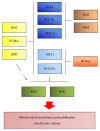Targeting BCL2-Proteins for the Treatment of Solid Tumours
- PMID: 26556430
- PMCID: PMC4590949
- DOI: 10.1155/2014/943648
Targeting BCL2-Proteins for the Treatment of Solid Tumours
Abstract
Due to their central role in the regulation of apoptosis, the antiapoptotic BCL2-proteins are highly promising targets for the development of novel anticancer treatments. To this end, several strategies have been developed to inhibit BCL2, BCL-XL, BCL-w, and MCL1. While early clinical trials in haematological malignancies demonstrated exciting single-agent activity of BCL2-inhibitors, the response in solid tumours was limited, indicating that, in solid tumours, different strategies have to be developed in order to successfully treat patients with BCL2-inhibitors. In this review, the function of the different antiapoptotic BCL2-proteins and their role in solid tumours will be discussed. In addition, a comprehensive analysis of current small molecules targeting these antiapoptotic BCL2-proteins (e.g., ABT-737, ABT-263, ABT-199, TW-37, sabutoclax, obatoclax, and MIM1) will be provided including a discussion of the results of any clinical trials. This analysis will summarise the potential of BCL2-inhibitors for the treatment of solid tumours and will unravel novel approaches to utilise these inhibitors in clinical applications.
Figures



Similar articles
-
Targeting of BCL2 Family Proteins with ABT-199 and Homoharringtonine Reveals BCL2- and MCL1-Dependent Subgroups of Diffuse Large B-Cell Lymphoma.Clin Cancer Res. 2016 Mar 1;22(5):1138-49. doi: 10.1158/1078-0432.CCR-15-1191. Epub 2015 Oct 14. Clin Cancer Res. 2016. PMID: 26467384
-
Reprogramming cell death: BCL2 family inhibition in hematological malignancies.Immunol Lett. 2013 Sep-Oct;155(1-2):36-9. doi: 10.1016/j.imlet.2013.09.015. Epub 2013 Oct 1. Immunol Lett. 2013. PMID: 24095849 Review.
-
Targeting sphingosine kinase 2 suppresses cell growth and synergizes with BCL2/BCL-XL inhibitors through NOXA-mediated MCL1 degradation in cholangiocarcinoma.Am J Cancer Res. 2019 Mar 1;9(3):546-561. eCollection 2019. Am J Cancer Res. 2019. PMID: 30949409 Free PMC article.
-
Confounding off-target effects of BH3 mimetics at commonly used concentrations: MIM1, UMI-77, and A-1210477.Cell Death Dis. 2019 Feb 22;10(3):185. doi: 10.1038/s41419-019-1426-3. Cell Death Dis. 2019. PMID: 30796196 Free PMC article.
-
Posttranslational modifications of Bcl2 family members--a potential therapeutic target for human malignancy.Front Biosci. 2006 May 1;11:1508-21. doi: 10.2741/1900. Front Biosci. 2006. PMID: 16368533 Review.
Cited by
-
Strategies to Reduce the On-Target Platelet Toxicity of Bcl-xL Inhibitors: PROTACs, SNIPERs and Prodrug-Based Approaches.Chembiochem. 2022 Jun 20;23(12):e202100689. doi: 10.1002/cbic.202100689. Epub 2022 Mar 19. Chembiochem. 2022. PMID: 35263486 Free PMC article. Review.
-
KPNB1 inhibition disrupts proteostasis and triggers unfolded protein response-mediated apoptosis in glioblastoma cells.Oncogene. 2018 May;37(22):2936-2952. doi: 10.1038/s41388-018-0180-9. Epub 2018 Mar 9. Oncogene. 2018. PMID: 29520102 Free PMC article.
-
Cordycepin Enhanced Therapeutic Potential of Gemcitabine against Cholangiocarcinoma via Downregulating Cancer Stem-Like Properties.Biomol Ther (Seoul). 2024 May 1;32(3):369-378. doi: 10.4062/biomolther.2023.198. Epub 2024 Apr 9. Biomol Ther (Seoul). 2024. PMID: 38589021 Free PMC article.
-
ABT-263 induces G1/G0-phase arrest, apoptosis and autophagy in human esophageal cancer cells in vitro.Acta Pharmacol Sin. 2017 Dec;38(12):1632-1641. doi: 10.1038/aps.2017.78. Epub 2017 Jul 10. Acta Pharmacol Sin. 2017. PMID: 28713162 Free PMC article.
-
Cancer Stem Cell and Gastrointestinal Cancer: Current Status, Targeted Therapy and Future Implications.Biochem Pharmacol (Los Angel). 2016;5(2):202. doi: 10.4172/2167-0501.1000202. Epub 2016 Feb 26. Biochem Pharmacol (Los Angel). 2016. PMID: 31656694 Free PMC article.
References
Publication types
LinkOut - more resources
Full Text Sources
Other Literature Sources
Research Materials

